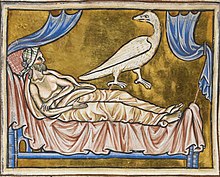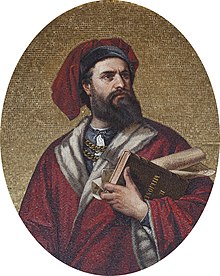| Part of a series on the |
| Culture of Italy |
|---|
 |
| People |
| Traditions |

Folklore of Italy refers to the folklore and urban legends of Italy. Within the Italian territory, various peoples have followed one another over time, each of which has left its mark on current culture. Some tales also come from Christianization, especially those concerning demons, which are sometimes recognized by Christian demonology. Italian folklore also includes the genre of the fairy tale (where the term itself was born[1]), folk music, folk dance and folk heroes.
Below is a list of the folklore figures who have animated Italian folk tales since ancient Rome.













|
See also: List of folk heroes |



|
Main article: Italian folk dance |

Italian folk dance has been an integral part of Italian culture for centuries. Dance has been a continuous thread in Italian life from Dante through the Renaissance, the advent of the tarantella in Southern Italy, and the modern revivals of folk music and dance. One of the earliest attempts to systematically collect folk dances is Gaspare Ungarelli's 1894 work Le vecchie danze italiane ancora in uso nella provincia bolognese ("Old Italian dances still in use in the province of Bologna") which gives brief descriptions and music for some 30 dances.[135]
In 1925, Benito Mussolini's government set up the Opera Nazionale Dopolavoro (OND) or National Recreational Club as a means of promoting sports and cultural activities and one of its accomplishments was a wide survey of folk music and dance in Italy at that time. The work was published in 1931 as Costumi, musica, danze e feste popolari italiane ("Italian popular customs, music, dance and festivals"). In September 1945 OND was replaced by a new organization, the Ente Nazionale Assistenza Lavoratori (ENAL), headquartered in Rome. In partnership with the International Folk Music Council, ENAL sponsored a Congress and Festival in Venice September 7–11, 1949 which included many of the outstanding researchers in Italian folklore as well as folk dance and music groups from various Italian regions.[136][137]
ENAL was dissolved in late 1978 but earlier in October 1970, the Italian folklore groups who had been members of ENAL set up a separate organization, which in 1978 became the Federazione Italiana Tradizioni Populari (FITP). The FITP publishes a newsletter and a scholarly publication Il Folklore D'Italia.[138] An interest in preserving and fostering folk art, music and dance among Italian Americans and the dedication and leadership of Elba Farabegoli Gurzau led to the formation of the Italian Folk Art Federation of America (IFAFA) in May 1979. The group sponsors an annual conference and has published a newsletter, Tradizioni, since 1980.[139]
|
Main article: Italian folk music |

Italian folk music has a deep and complex history. National unification came quite late to the Italian peninsula, so its many hundreds of separate cultures remained un-homogenized until quite recently. Moreover, Italian folk music reflects Italy's geographic position at the south of Europe and in the center of the Mediterranean Sea: Celtic, Slavic, Arabic, Greek, Spanish and Byzantine influences are readily apparent in the musical styles of the Italian regions. Italy's rough geography and the historic dominance of small city states has allowed quite diverse musical styles to coexist in close proximity.
The Celtic and Slavic influences on the group and open-voice choral works of the Northern Italy contrast with the Greek, Byzantine, and Arabic influenced strident monody of the Southern Italy.[140] In the Central Italy these influences combine, while indigenous traditions like narrative and ballad singing remain. The music of the island of Sardinia is distinct from that of the rest of Italy, and is best known for the polyphonic chanting of the tenores.
The modern understanding of Italian folk music has its roots in the growth of ethnomusicology in the 1940s and 1950s and in the resurgence of regionalism in Italy at the time. The Centro Nazionale di Studi di Musica Popolare (CNSMP), now part of the Accademia Nazionale di Santa Cecilia, was started in 1948 to study and archive the various musical styles throughout Italy. The Italian folk revival was accelerating by 1966, when the Istituto Ernesto de Martino was founded by Gianni Bosio in Milan to document Italian oral culture and traditional music. Today, Italy's folk music is often divided into several spheres of geographic influence, a classification system proposed by Alan Lomax in 1956 and often repeated since.[141]